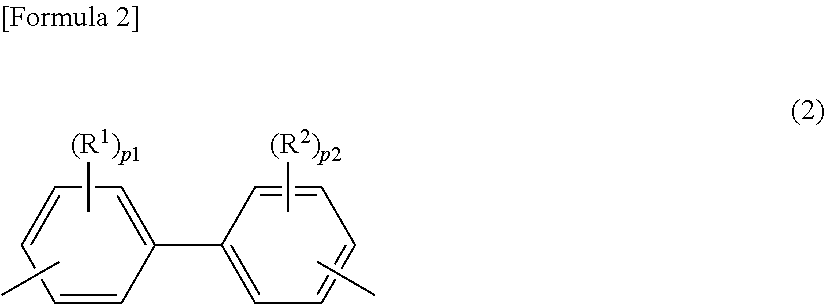Polycarbonate copolymer, coating fluid using same, electrophotographic photoreceptor, and method for producing polycarbonate copolymer
a technology of polycarbonate copolymer and coating liquid, which is applied in the direction of coating, optics, instruments, etc., can solve the problems of insufficient durability and wear resistance of polycarbonate resin, and achieve the effects of reducing solubility, increasing crystallinity, and preventing disadvantages
- Summary
- Abstract
- Description
- Claims
- Application Information
AI Technical Summary
Benefits of technology
Problems solved by technology
Method used
Image
Examples
manufacturing example 1
Synthesis of 4,4′-biphenol Oligomer (Bischloroformate)
[0280]50.0 g (0.269 mol) of 4,4′-biphenol, 500 ml of methylene chloride and 80.0 g (0.809 mol) of phosgene were mixed into a solution. To the mixed solution, a solution prepared by diluting 59.8 g (0.591 mol) of triethylamine in 100 ml of methylene chloride was dropped at 13 to 16 degrees C. for three hours and six minutes. The reactant mixture was stirred at 14 to 16 degrees C. for one hour and 38 minutes. 5.0 ml of concentrated hydrochloric acid and 200 ml of deionized water were added to the reactant mixture for cleaning. Subsequently, water cleaning was repeated until an aqueous layer became neutral. The resultant methylene chloride solution was a bischloroformate compound-containing solution (897.5 g).
[0281]The obtained solution had a chloroformate concentration of 0.83 mol / L, a solid concentration of 0.13 kg / L and an average number of monomer units of 1.00. This obtained ingredient will be referred to as “BP-CF 1” hereinaft...
manufacturing example 2
Synthesis of 4,4′-biphenol Oligomer (Bischloroformate)
[0284]50.0 g (0.269 mol) of 4,4′-biphenol, 500 ml of methylene chloride and 54.5 g (0.551 mol) of phosgene were mixed into a solution. To the mixed solution, a solution prepared by diluting 59.8 g (0.591 mol) of triethylamine in 100 ml of methylene chloride was dropped at 13 to 16 degrees C. for one hours and 36 minutes. The reactant mixture was stirred at 14 to 16 degrees C. for one hour and 38 minutes. 5.0 ml of concentrated hydrochloric acid and 200 ml of deionized water were added to the reactant mixture for cleaning. Subsequently, water cleaning was repeated until an aqueous layer became neutral. The resultant methylene chloride solution was a bischloroformate compound-containing solution (880.2 g).
[0285]The solution had a chloroformate concentration of 0.91 mol / L, a solid concentration of 0.20 kg / L and an average number of repeating units of 1.61. This obtained ingredient will be referred to as “BP-CF2” hereinafter.
manufacturing example 3
Synthesis of 3,3′-dimethyl-4,4′-dihydroxy-biphenyl Oligomer (Bischloroformate)
[0286]57.7 g (0.269 mol) of 3,3′-dimethyl-4,4′-dihydroxy-biphenyl, 500 ml of methylene chloride and 80.0 g (0.809 mol) of phosgene were mixed into a solution. To the mixed solution, a solution prepared by diluting 59.8 g (0.591 mol) of triethylamine in 100 ml of methylene chloride was dropped at 13 to 16 degrees C. for three hours and six minutes. The reactant mixture was stirred at 14 to 16 degrees C. for one hour and 38 minutes. 5.0 ml of concentrated hydrochloric acid and 200 ml of deionized water were added to the reactant mixture for cleaning. Subsequently, water cleaning was repeated until an aqueous layer became neutral. The resultant methylene chloride solution was a bischloroformate compound-containing solution (910.2 g).
[0287]The obtained solution had a chloroformate concentration of 0.82 mol / L, a solid concentration of 0.145 kg / L and an average number of monomer units of 1.09. This obtained ingr...
PUM
| Property | Measurement | Unit |
|---|---|---|
| molecular weight distribution | aaaaa | aaaaa |
| thickness | aaaaa | aaaaa |
| thickness | aaaaa | aaaaa |
Abstract
Description
Claims
Application Information
 Login to View More
Login to View More - R&D
- Intellectual Property
- Life Sciences
- Materials
- Tech Scout
- Unparalleled Data Quality
- Higher Quality Content
- 60% Fewer Hallucinations
Browse by: Latest US Patents, China's latest patents, Technical Efficacy Thesaurus, Application Domain, Technology Topic, Popular Technical Reports.
© 2025 PatSnap. All rights reserved.Legal|Privacy policy|Modern Slavery Act Transparency Statement|Sitemap|About US| Contact US: help@patsnap.com



